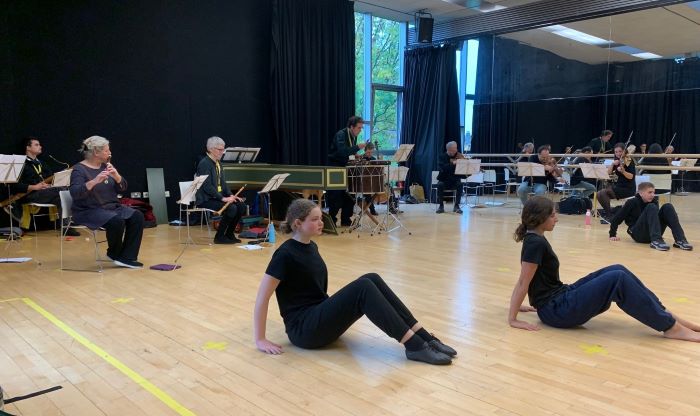Arts and Culture
Article
Insights & Innovation
58dbde4b-56f6-4f52-8c9a-1527882e4855
5 min
https://edge.sitecorecloud.io/tessituraneab9a-tessiturane5642-staging-5396/media/Images/Discover-Images/Thought-Leadership/Five-Superpowers/Commonality-Rameau-768x465.png?h=465&iar=0&w=768
The power of arts and culture to gently dismantle barriers
Arts & culture: best common denominator

President & CEO, Tessitura
Arts & culture: best common denominator
2/3/2022
5 min
“Music is a world within itself, with a language we all understand.”
— Stevie Wonder
Consider these two groups: the first, seasoned classical music performers working in posh central London; the second, teens at a public school in working-class Camden. One would be hard-pressed to find two groups in London with less in common.
In 2019, the Orchestra of the Age of Enlightenment (OAE) inked an agreement with Acland Burghley Secondary School to rent extra space in the school’s administrative offices. More than just a lease, this arrangement was an ingenious experiment aiming to meet fundamental needs of both institutions. The school was looking to add new creative inputs for their students, and the orchestra wanted to play a truly immersive part in the life of a London community.
The school was looking to add new creative inputs for their students, and the orchestra wanted to play a truly immersive part in the life of a London community.
Just before the students returned from summer holiday, the orchestra moved their administrative offices, music library, and instrument storage to their new home.
Recalling those first few days, Crispin Woodhead, the OAE’s Chief Executive, laughed and said, “We landed like aliens!” The students didn’t know what to make of the musicians strolling through their halls, the herald trumpets welcoming them in the morning, or the harpsichords in the Assembly Hall.

Members of the Orchestra serenading students on the first day of school.
Shortly after settling in, the orchestra approached a student dance group and asked if they would like to collaborate. The students were skeptical. Undeterred, the musicians suggested a few pieces. Reviewing the options, the students felt a spark with a piece by the Baroque composer Rameau, written in 1735.
Classical music can sometimes be characterized as slow, boring and unapproachable. This piece was not. It was loud and percussive, and the tune was an earworm. To Rameau’s original score, the students added their own claps, snaps and foot stomps. They invented choreography, added lighting design, and recorded it all on video. The result was a new work of art: a short film by the Acland Burghley students featuring a soundtrack by the Orchestra of the Age of Enlightenment.
I think it is miraculous. The music may be 280 years old, but in the hands of the student dancers and orchestra musicians, it feels current, vibrant and alive. The two groups may have little in common, but through music and dance they found common ground. No one seemed like aliens anymore.

Students rehearsing their new dance work with the Orchestra.
I believe there is a lesson here about the power of arts and culture to bridge a large divide between two very different groups. But what about adversarial relationships? In fact, there are plenty of examples of arts and culture serving as a neutral point of entry when there is extreme conflict at play.
In the 1980s, peacebuilders in Northern Ireland utilized youth theater and music festivals to “gently dismantle barriers” between opposing sides as part of what became known as the “Derry experiment.” Along with other activities, the work in Derry served as the precursor to the formal peace talks in Northern Ireland.
In the Middle East, Israeli conductor Daniel Barenboim and Palestinian academic Edward Said co-founded the West-Eastern Divan Orchestra comprised of Arab, Israeli and Persian musicians. For more than 20 years, the orchestra has leveraged the commonality of music to promote understanding in the Middle East.
“If two people sing the same tune, and realize they have something in common, the other person can’t be all bad, because music identifies our humanity.”
— Yo-Yo Ma
Ideology, politics, religion or even geography can create barriers that lead to distrust and conflict. Shared arts & culture experiences help us gently dismantle those barriers so we can celebrate what we have in common. That is the power of arts and culture to foster commonality.
• • •
Tessitura has a vision: Working toward a day when every human in every community we serve has arts and culture as a meaningful part of their life.
This is the fifth in a series of posts where Andrew explores ways that cultural organizations can work toward that vision. You can see Andrew’s talk on the topic here: The Five Superpowers of Arts and Culture.
Top photo: Still from the short film by the Acland Burghley students.
Topics
Arts & Culture

Why Arts & Culture is Essential Today
Arts & Culture
Healing the world requires five human traits: arts & culture delivers them all.

A contactless customer journey with a personal touch
Arts & Culture / Business Strategy / COVID-19 / Technology / Ticketing & Admissions
How Georgia Aquarium creates a visitor-focused experience
